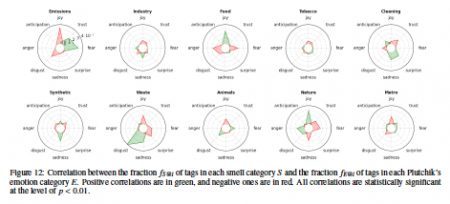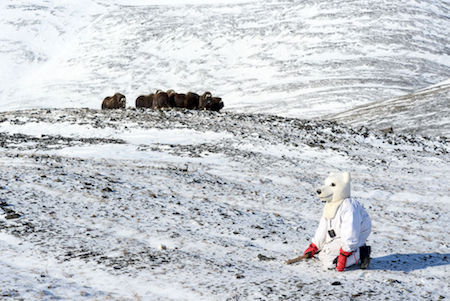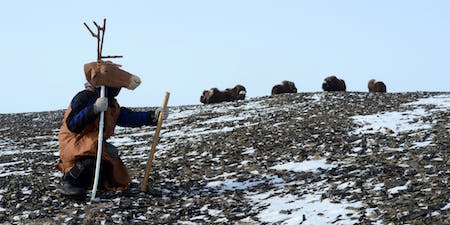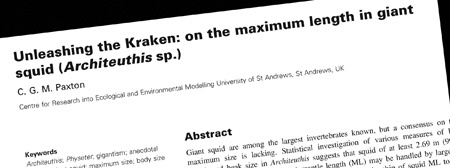Marc Abrahams's Blog, page 266
June 7, 2016
Quantifying the Smell of Urban Areas
Data analysis has led to numerous insights into a diverse variety of complex systems. A new paper that gives a whiff of such insights is The Emotional and Chromatic Layers of Urban Smells by Daniele Quercia of Bell Labs, Luca Maria Aiello of Yahoo Labs, and Rossano Schifanella of University of Turin.
Quercia et al. write the following in their abstract:
People are able to detect up to 1 trillion odors. Yet, city planning is concerned only with a few bad odors, mainly because odors are currently captured only through complaints made by urban dwellers. To capture both good and bad odors, we resort to a methodology that has been recently proposed and relies on tagging information of geo-referenced pictures. In doing so for the cities of London and Barcelona, this work makes three new contributions. We study 1) how the urban smellscape changes in time and space; 2) which emotions people share at places with specific smells; and 3) what is the color of a smell, if it exists. Without social media data, insights about those three aspects have been dicult to produce in the past, further delaying the creation of urban restorative experiences.
As we can see from this work, no matter whether one is spending time in London or in Barcelona, a city by any other name would smell just as… uh, sweet. And perhaps be associated with just as much joy, trust, anticipation, or surprise?

A figure from the paper by Quercia et al. that examines the correlation between various types of emotions and various types of smells.
Clearly, this is research that we need to savor.

June 6, 2016
Multifunction baby carrier exercise device (new patent)
“The care of a newborn baby is virtually a 24 hour a day job, leaving very little time for new parents to engage in traditional exercise. The lack of exercise runs contrary to traditional and prevailing medical opinions.”
Fortunately, inventor Scott Krass of San Diego, California, has invented (and just received a US patent for) a ‘Multifunction baby carrier exercise device’ which allows new parents not only to care for their infant, but also to exercise at the same time…
Note that the patent document’s first sentence describes the device as suitable for an ‘animal’ – possibly to allow scope for the invention to be used for animals other than humans – say for example, dogs, cats etc. etc..
“An apparatus, comprising: a first part configured to accommodate an animal, the first part comprising an interior portion, an exterior portion, an anterior portion for placing the animal’s head, and a posterior portion for placing the animal’s lower extremities; a second part configured to both support the animal and provide a grasp for at least one hand of a user, wherein the second part comprises a strap having first, second, third, and fourth portions, the first portion securely fastened to and directly contacting the exterior portion of the first part continuously all along a first area of the exterior portion of the first part, the second portion securely fastened to and directly contacting the exterior portion of the first part continuously all along a second area of the exterior portion of the first part; and the third and fourth portions each forming a loop extending from one of the edges on opposite sides of the first part; and a third part configured to swaddle the animal within the first part, wherein the first part consists of foldable fabric and comprises first and second edges and the first and second edges are caused to approach each other to form a hammock-like shape to further swaddle the animal when the user holds the grasp and lifts the apparatus, wherein the entire first part between the first and second edges provides a non-rigid surface for supporting the animal and is capable of being foldable around the animal, and wherein the first area of the exterior portion of the first part is juxtaposed with the anterior portion of the first part, and the second area of the exterior portion of the first part is juxtaposed with the posterior portion of the first part.”

June 5, 2016
How do muskoxen react to humans disguised as polar bears?
The recent experiment by Joel Berger and colleagues, to test how muskoxen react to humans disguised as polar bears, was inspired by the Ig Nobel Prize-winning experiment done by two Norwegian scientists. This brief video shows the new experiment:
The 2014 Ig Nobel Prize for arctic science was awarded to Eigil Reimers and Sindre Eftestøl, for testing how reindeer react to seeing humans who are disguised as polar bears. That research is documented in the study “Response Behaviors of Svalbard Reindeer towards Humans and Humans Disguised as Polar Bears on Edgeøya,” Eigil Reimers and Sindre Eftestøl, Arctic, Antarctic, and Alpine Research, vol. 44, no. 4, 2012, pp. 483-9.
The Wildlife Conservation Society issued a press release about the new experiment:
The trip was spearheaded by Dr. Joel Berger of the WCS (Wildlife Conservation Society) Arctic Beringia Program and professor at Colorado State University, in collaboration with his Russian colleagues Dr. Alexander Gruzdev, Ilya Borisovich, Igor Oleinikov, Grigory Nikolaevich, and Sergey Abarok.
Expedition members brought back stunning photos and video taken during this expedition, including a charge of the scientists by a muskox. Berger approached a herd of 40 muskoxen dressed alternately as a polar bear and as a caribou, to gauge responses to species the animals may increasingly encounter due to climate change.
Mary Beth Griggs writes about the new experiment, in Popular Science, with this photo of the human in the polar bear suit:
Jacqueline Ronson, too, writes about the new experiment, in Inverse: “This Scientist Donned a Polar Bear Suit to Chase Muskoxen Around the Arctic.” It features this photo of a human in a caribou costume, acting as a control — something to provoke (or not) the muskoxen by way of comparison with the provocation of the human in the polar bear costume:

Nestlé, Phoenix water, the bicycle shed problem, and Parkinson’s Law of Triviality

A bicycle shed.
John Fleck explains how big and little problems can get tangled in one’s mind. His essay is called “Nestlé, Phoenix water, and the bicycle shed problem“:
“Back in my errant youth, when I worked as a volunteer documentation writer for the big free software GNOME project, I became intimately familiar with what we called ‘bicycle shed’ discussions, a shorthand drawn from the work of 1950s management scholar C. Northcote Parkinson [pictured below]. Here’s a nice short explanation:
Parkinson shows how you can go in to the board of directors and get approval for building a multi-million or even billion dollar atomic power plant, but if you want to build a bike shed you will be tangled up in endless discussions.
Parkinson explains that this is because an atomic plant is so vast, so expensive and so complicated that people cannot grasp it, and rather than try, they fall back on the assumption that somebody else checked all the details before it got this far….
A bike shed on the other hand. Anyone can build one of those over a weekend, and still have time to watch the game on TV. So no matter how well prepared, no matter how reasonable you are with your proposal, somebody will seize the chance to show that he is doing his job, that he is paying attention, that he is *here*.

C. Northcote Parkinson.
“Sometimes also called “Parkinson’s law of triviality“, it’s popular among geeks and mostly applied to software development discussions. But it generalizes, a nice shorthand for why people attach to simple things they think they can understand and act on, while ignoring the more important but vast and complex. I get why bicycle shed discussions are inevitable. But that doesn’t mean they are not a problem.
“Here’s why, in the case of Phoenix and Nestlé.…”

Antisubmarining pans for buttocks engagement
“Antisubmarining pans for buttocks engagement” feature in the brochure for this event:
“Frontiers in Vehicle Safety Technology and Testing — A one-day seminar/workshop,” Engineers Australia’s Injury Biomechanics National Panel, Wednesday, 12 November 2008, National Convention Centre Adelaide, Australia. The brochure for the event explains:
“Rear seats are not a copy of front seats. The enhanced safety technology such as antisubmarining pans for buttocks engagement, force limiters, pretensioners, side airbags, enhanced seatbelt geometry, are not currently required by regulation in rear seats. Also they are not assessed in consumer programs. As a result, any flow on of improved safety technology for front seats is almost entirely a matter of voluntary application by the vehicle industry. In many of the more popular vehicles, rear seat safety technology lags several decades behind front seats.”
BONUS: A subject-specific model of human buttocks

June 4, 2016
To Push a Tooth
Only a few documented experiments have measured the result of pushing a single tooth at either of two positions along the tooth, for purposes of understanding the brain. Here is one such study:
“Forces, movements and reflexes produced by pushing human teeth,” Brendan J.J. Scott [pictured here], Andrew G. Mason and Samuel W. Cadden, Experimental Brain Research, May 2012, Volume 218, Issue 4, pp 629-637. The authors, at the University of Dundee, conclude:
“Reflexes were evoked by pushing at two positions (incisal and cervical) on an upper central incisor…. it appears that neither tooth movements nor jaw reflexes are dependent on the point of force application to a tooth.”

June 3, 2016
Olly the Cat (r.i.p.) and feline politics in organization
“[…] a ginger mackerel tabby cat is sat on a mat at the foot of the marble entrance. It is sat outside the entrance to its own rather imposing mini ‘Berkshire-style’ wooden townhouse that abuts the tinted windows of the concrete and glass steel tower of Olympic House.” [a building at Manchester Airport, UK].
The airport cat, called ‘Olly’, is the principal subject of a May 2016 paper in the journal Organization, entitled ‘Feline politics in organization: The nine lives of Olly the cat’ – an ethnographic examination of possible feline challenges to orthodox understanding(s) of agency and organizational action.
“As the ethnography becomes progressively more implicated in the entanglements between human and animal, the concept of ‘feline politics’ is proposed and deployed”
– explains Dr. Damian P. O’Doherty, who is a senior lecturer at Manchester Business School, The University of Manchester, UK.

“Olly was providing a resource that helped members of organization find a mode of orientation to the wider organization that was not simply representational but also ‘constitutive’ and interventionary, manifest in tangible and ‘material’ form and in behaviours and activities that made the organization work in other ways.”
“This article adds to what we know about the limits of management as it confronts a radical undecidability characterized by the co-existence of multiple and interacting ontological becomings.”
Note: Sadly, since publication of the paper, Olly [ a.k.a. ‘Ollie’] recently passed away.

June 2, 2016
The Ig Nobel Prizes are a category on Jeopardy, for the 6th time
The television quiz show Jeopardy used the Ig Nobel Prizes as a category, in the program broadcast yesterday (June 1, 2016). This was the sixth time that the Igs have been a Jeopardy category (previous appearances were in 2005, 2006, 2008, 2010, and 2012). Here are the answers from last night:

When Absence of Evidence Is Evidence of Absence
“Identifying patterns in the world requires noticing not only unusual occurrences, but also unusual absences.”
– inform professor Anne S. Hsu and colleagues Andy Horng, Thomas L. Griffiths and Nick Chater in a new paper for the journal Cognitive Science.
“
We examined how people learn from absences, manipulating the extent to which an absence is expected. People can make two types of inferences from the absence of an event: either the event is possible but has not yet occurred, or the event never occurs. A rational analysis using Bayesian inference predicts that inferences from absent data should depend on how much the absence is expected to occur, with less probable absences being more salient. We tested this prediction in two experiments in which we elicited people’s judgments about patterns in the data as a function of absence salience. We found that people were able to decide that absences either were mere coincidences or were indicative of a significant pattern in the data in a manner that was consistent with predictions of a simple Bayesian model.”
See: ‘When Absence of Evidence Is Evidence of Absence: Rational Inferences From Absent Data’
For further explorations regarding the implications of things which may or may not, to some extent or other, be there, also see: The Presence of the Absence of Absences + Maybe no data? Maybe no problem? + Non-ignor ble mis ingn ss + Almost nothings

June 1, 2016
From ostrich-human courtship to squid possible gigantic-ness
Charles Paxton, the University of St. Andrews professor who shared the 2002 Ig Nobel biology prize for study called “Courtship Behaviour of Ostriches Towards Humans Under Farming Conditions in Britain” (published in British Poultry Science, vol. 39, no. 4, September 1998, pp. 477-481) has a new study out, about giant squid.
The new study seems to have enraged certain persons (see below).
The study is: “Unleashing the Kraken: on the maximum length in giant squid (Architeuthis sp.),” Charles G.M. Paxton, Journal of Zoology, epub 17 May 2016. Here’s what it says:
Giant squid are among the largest invertebrates known, but a consensus on their maximum size is lacking. Statistical investigation of various measures of body length and beak size in Architeuthis suggests that squid of at least 2.69 m (99.9% prediction interval: 1.60–3.83 m) mantle length (ML) may be handled by large bull sperm whales but perhaps not females. Given the relationship of squid ML to standard (from tip of mantle to end of arms) and total (from tip of mantle to end of tentacles) length, the observed spread of individual lengths, along with a longest reliably measured ML of 2.79 m, purported squid of 10 m standard length and even 20 m total length are eminently plausible.
Michael Greshko writes, for National Geographic, about the study and the varied reactions to it:
Giant Squid Could Be Bigger Than a School Bus
The deep-dwelling creatures could reach lengths of at least 66 feet, says a provocative new study—but not everyone is convinced….Paxton’s results, published on May 17 in the Journal of Zoology, have released a kraken of controversy: At present, there’s no physical evidence that the giant squid (Architeuthis dux) actually gets as large as Paxton is claiming, leading some to doubt the study’s real-world relevance. (See National Geographic’s squid pictures.)
“This paper will certainly boost his citation indices, but probably for all the wrong reasons,” wrote giant squid expert Steve O’Shea, who wasn’t involved with the study….
Rebecca Goldin, a professor of mathematics at George Mason University and director of STATS.org, finds Paxton’s statistical arguments to be sound, though recommends caution in applying the results.
“My takeaway is that the author has a point: The variability is high enough that whales may have eaten larger squid than so far found,” Goldin, who wasn’t involved with the study, said by email.
BONUS: Charles Paxton’s discoveries are wide-ranging. A few years ago, he published a study pointing out that one celebrated historical account of a “sea monster” may have been a misunderstanding on the part of the observer. What the observer saw was (the study explains) most likely a whale’s erect penis.

Marc Abrahams's Blog
- Marc Abrahams's profile
- 14 followers








